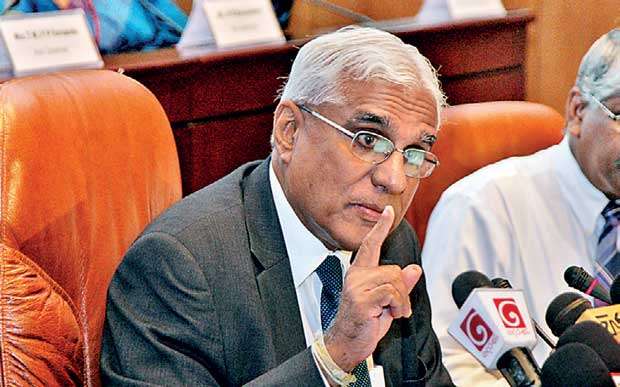Reply To:
Name - Reply Comment

Indrajith Coomaraswamy
Pic by Damith Wickremesinghe
By Nishel Fernando
The Monetary Board of the Central Bank of Sri Lanka yesterday decided to maintain policy interest rates at their current levels amidst monetary policy tightening in the United States and other major economies, strengthening of the US dollar, pressures on currencies of many emerging market economies and escalating
trade tensions.
Accordingly, the Standing Deposit Facility Rate (SDFR) and Standing Lending Facility Rate (SLFR) of the Central Bank will remain at 7.25 per cent and 8.50 per cent, respectively.
CBSL Governor Indrajith Coomaraswamy said, “The global interest rates are easing up. We see particularly the benchmark US bond deals going up recent days once again, which is a factor for policy tightening in advanced countries. So if we allow the differential between our rates and the benchmark rates, particularly US to be reduced, then clearly there is an incentive for foreign investors in government securities to move out. There has been already some outflow, but if that differential gets squeezed, you could see acceleration of that outflow.”
The net rupee denominated government security market has experienced a net outflow of US$229 million by foreign investors up to first of August this year. Despite an outflow of US$16.3 million from the secondary market, the Colombo Stock Exchange (CSE) attracted a net inflow of US $44.7 million as a result of primary market transactions.
He noted that a number of emerging market countries has increased their interest rates and hence, the loosening of Sri Lanka monetary policy would have an adverse impact on government securities.
“If we reduce our interest rates while these countries are reducing it, then we could see some repositioning which could have an adverse impact on the investment of foreign money in our government securities,” he noted.
Sri Lanka’s gross official foreign reserves position is estimated at around US$8.4 billion by end of July, and the CBSL has absorbed US$133.9 million from the domestic market by the end of July in defending the rupee as it depreciated by 4.3 percent this year, mainly reflecting the US$’s broad based strengthening in global markets.
“If we reduce the interest rates that would further trigger the pressure on the exchange rate at a time when a number of emerging market currencies are experiencing a deprecation pressure,” the Governor pointed out.
He said that CBSL was also concerned on the deterioration of the trade account during the first five months.
While noting that the government actually met its fiscal targets for the first six months of the year, Dr. Coomaraswamy said CBSL is leaving room to adjust the monetary policy, if there’s a slippage in the fiscal front.
CBSL also remains confident on achieving the inflation target by end of this year, despite an uptick in inflation last month.
“Inflation outlook remains favourable. It went up to 5.4 percent in July and it’s likely to remain in that level or little higher this month as well, and then we will see an easing off towards the end of the year, we expect the inflation to be contained within a target range of 4-6 percent by end of the year,” he said.
The CBSL expects that the onset of the harvest towards the end of the third quarter of 2018 would lower the inflation thereafter.
The private sector credit growth decelerated to 14.9% YoY in June 2018 from 15.1 percent in May, and the CBSL expects the private sector credit growth to moderate by around 13-14 percent by end of this year.
Simultaneously, the growth in the broad money supply (m2b) also decelerated to 14.9 percent YoY from 15 percent in May, with the deceleration in private sector credit expansion and net borrowing by the government from the banking system.
The CBSL responding to prevailing surplus liquidity conditions in the domestic money market stated that short term interest rates have begun to adjust downwards. Yields on government securities in both primary and secondary markets have also declined recently.
However, Dr. Coomaraswamy noted that deposit rates and real interest rates remain rigid despite these developments.
“A matter of some concern is that bank deposit and lending rates are rigid as they are. In fact, this concern was expressed to CEOs of banks at the recent monetary meeting. We do think that bank deposit and lending rates now need to come down. As we monitor that, we could see how it develops,” he said.